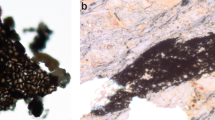Abstract
IN studies of peat deposits from south-western Australia, a number of small fossil algæ have been found with a morphology similar to certain living polyhedral unicellular species of the family Oocystaceae of the Chlorococcales. The classification of this family is artificial1 and is based on the type of colony produced. Genera which have been placed in the family include Tetraedron, Desmatractum, Octogoniella and Scotiella 1–3. Two of these, Octogoniella and Desmatractum, have a peculiar form characterized by two envelopes, separated by a more or less wide space containing an aqueous mucilage. The inner envelope is delicate, while the outer is composed of two conical halves joined together in the median plane.
This is a preview of subscription content, access via your institution
Access options
Subscribe to this journal
Receive 51 print issues and online access
$199.00 per year
only $3.90 per issue
Buy this article
- Purchase on Springer Link
- Instant access to full article PDF
Prices may be subject to local taxes which are calculated during checkout
Similar content being viewed by others
References
Smith, G. M., “Cryptogamic Botany”, 1, “Algae and Fungi” (McGraw-Hill, New York, 1938).
Fritsch, F. E., “The Structure and Reproduction of the Algae”, 1 (Cambridge University Press, 1948).
Prescott, G. W., “How to Know the Freshwater Algae” (W. M. C. Brown Co., Iowa, 1954).
Author information
Authors and Affiliations
Rights and permissions
About this article
Cite this article
CHURCHILL, D. Living and Fossil Unicellular Algæ and Aplanospores. Nature 186, 493–494 (1960). https://doi.org/10.1038/186493b0
Issue Date:
DOI: https://doi.org/10.1038/186493b0
This article is cited by
Comments
By submitting a comment you agree to abide by our Terms and Community Guidelines. If you find something abusive or that does not comply with our terms or guidelines please flag it as inappropriate.



